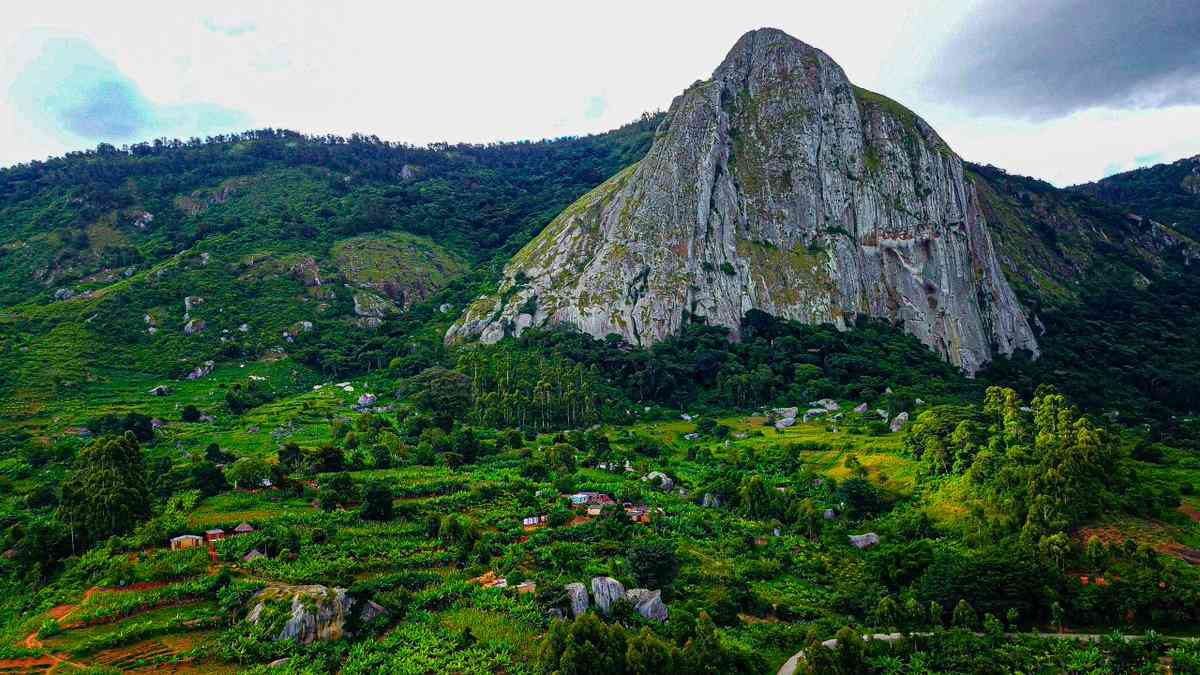
IN this age of artificial intelligence, rapid urbanisation and various kinds of innovation, it is easy to ignore the central role, which trees and forests play, in sustaining social and economic development.
If the importance of forests is not acknowledged, a country’s natural environment can be degraded until it reaches crisis levels.
This is why it is crucial for policymakers to keep track of the state of the country’s forests and other components of the natural environment.
Also, economic or social development cannot be assured when a country's natural environment has been devastated.
State of the forests
The whole of Zimbabwe covers an area of 39 million hectares. Forests make up about 47% (or 18 million hectares) of the country’s total surface area.
This is a sharp decline from 60% forest coverage, in 2001. Some 829 000 hectares of forests (gazetted forests) are comprehensively protected by special laws and government agencies, such as the Forestry Commission.
These protected areas provide habitat to wildlife and are rich in indigenous trees. They also attract tourists.
- Chamisa under fire over US$120K donation
- Mavhunga puts DeMbare into Chibuku quarterfinals
- Pension funds bet on Cabora Bassa oilfields
- Councils defy govt fire tender directive
Keep Reading
Other gazetted forests, however, have exotic tree plantations (mostly pine, wattle and eucalyptus trees), which are used in commercial operations, such as the manufacturing of timber for furniture, construction, etc.
The local forestry industry, which is based on the exotic tree plantations, contributes significantly to economic activity. It generally makes up 3%-4% of gross domestic product (GDP, the country's total economic activity) and used to employ as much as 14 600 workers between 2005-2010.
There is also the indigenous timber industry, which is primarily focused on local tree species (particularly the Zambezi teak), which are extracted from forests in north-western and western Zimbabwe.
It directly employs around 2000 people, with even more in the downstream furniture industry.
Due to construction and other economic activities, urban areas have less forest-cover than rural areas.
Zimbabwe loses around 260 000 hectares of forests to deforestation each year. The forests are mostly cleared to make way for construction projects, for firewood, due to forest fires and for agricultural purposes, among other things.
Informal sector (artisanal) miners are also notorious for diverting rivers, which supply local exotic tree plantations, in order to use the water as a resource in their alluvial mining.
In some cases, the same miners end up destroying some hills on which tree plantations are established due to the diversion of normal river flows.
Illegal settlers are also establishing their homes and agricultural plots in gazetted forests, which are not supposed to be inhabited (by people).
Currently, there are about 50 000 individuals occupying such gazetted forests, taking up as much as 60 000 hectares for their personal use.
Trees are also being cut down throughout the country's forests, for the production of charcoal which is then resold in various rural and urban markets.
Other illegal loggers extract wood in order to supply furniture and timber processors.
The government's current five-year development programme (NDS 1) targets to have 45 000 hectares of forests planted each year, by 2025.
However, current indications show that the country is still a long way from this desirable target.
For example, forestry projects linked to the tobacco sector, targeted to plant only 5 000 hectares of forests in 2023, against a deforestation rate of 60 000 hectares per year, caused by tobacco farmers alone.
The Forestry Commission is the government agency primarily responsible for preserving the country's forests. Its officers do extension work, research and uphold the laws pertaining to local forests, among other things.
There are also other local, international, public and private entities (mostly NGOs), which are also focused on the sound management of Zimbabwe’s forests and its natural environment. These include the World Bank, the Environmental Management Agency (Ema), conservation group- “Wild is Life”, etc.
Benefits or importance of forests
As stated earlier, the country's forests support the local tourism sector.
Tourism is the third-largest sector of Zimbabwe’s economy. Visits to national parks and monuments provide critical revenue to the tourism sector.
Trees and vegetation also support the beautification of both urban and rural areas.
In rural areas, forests provide villagers with firewood, fruits and construction materials, among other things. In terms of energy, firewood provides 62% of the country’s energy deficit.
This means that when households or businesses cannot access electricity, they mostly resort to firewood, instead of gas, paraffin, other petroleum fuels, etc.
Forests also support wildlife and livestock through the provision of vegetation for grazing and browsing. The population of such animals can be expected to decline, if forest degradation continues unrestricted.
If there were abundant forests, Zimbabwe's weather and rainfall patterns would improve. This is because dense forests enable a higher frequency of rains and a more humid atmosphere. Additionally, having more trees and vegetation within rainwater catchment areas, promotes the infiltration of rainwater into the ground.
This groundwater in catchment areas is the same, which acts as the source of the country’s various rivers. Therefore, with rich forests,
Zimbabwe's water sources would not dry up easily. These benefits are particularly crucial for the country, since only 19% of Zimbabwe receives abundant rainfall (agricultural regions 1 and 2), whilst only 30% of the soils are inherently (naturally) fertile.
Such statistics clearly indicate that without technological and technical interventions, Zimbabwe has low agricultural potential.
However, the conservation of forests is one of the ways in which the potential can be improved.
Trees are known to store up pollutants (greenhouse gasses), which include carbon dioxide. This enables them to reduce the degradation of the world's climate.
It is also possible for properly-managed local forests to be registered for tradable environmental stewardship projects, such as carbon credit schemes. Zimbabwe is already host to the world’s second-largest carbon credit project, known as the Kariba REDD+ (in Mashonaland West).
The United States Forestry Service posits that, 40% of the medicines sold in Western countries are derived from trees and other types of plants.
This statistic shows that the local pharmaceutical industry can derive useful medicinal innovations from Zimbabwean forests, if the commitment and funding are available.
The local forestry industry, which comprises both exotic and indigenous tree wood-processing, is a huge employer, and supports other economic sectors, such as the retail sector and construction.
Wooden furniture and various built structures, such as greenhouses, bridges and dams, depend on local forestry products for their construction.
Recommendations
In order to maintain sustainable social and economic progress, the country will need to increasingly include the management of forests in its development goals.
Also, the inclusion should not just be mere lip service. Rather it needs to be urgently and meticulously implemented.
There are numerous ways in which Zimbabwe can drive towards the creation of abundant forests and vegetative cover. Some of them are explained below.
Please note that the list of recommendations is not exhaustive (does not include all possible ways).
Zimbabwe needs to promote agroforestry. This entails encouraging all farmers to regularly plant trees on their plots. The farmers may include fruit, nut, exotic or indigenous trees, depending on their preferences.
The government also needs to look into the geographical distribution of households in rural areas. It appears that the current geographical distribution is not optimised to support social development and strong economic growth.
Villagers currently live in homesteads, which are too widely-spaced apart, with other households being as much as 10 kilometres from the nearest service-centre (growth point).
In that regard, it is advisable to gradually work towards the relocation of isolated villagers, so that they live as close to service-centres, as possible.
This will enable the distribution of public goods and services (roads, clinics, schools, etc) to be more economical. The hinterlands, from which the villagers would have been removed, can then be established to develop huge forestry and other commercially rewarding projects.
The government should also continue to expand the capacity of power stations so that they can generate sufficient energy for the whole country.
This will greatly reduce deforestation caused by the need for firewood.
Additionally, villagers in rural areas will need incentives such as title-deeds, in order to improve their commitment towards maintaining a sustainable natural environment in their places of residence and surrounding areas.
Experts argue that one of the major reasons why rural dwellers seem negligent and ignorant of the need for environmental sustainability is that their form of land ownership does not give them absolute and permanent rights over their properties in the form of title-deeds.
The same also applies to resettled farmers who benefitted from the land reform program of the year 2000.
Promoting the processing and commercialisation of indigenous fruit can give rise to the increase in planting of indigenous fruit trees. To encourage this, retail outlets may be encouraged to stock indigenous fruit as part of their products on sale, whilst informal traders (vendors) would be prohibited from selling the same, in any area close to formal shops.
The formalisation of indigenous fruit by promoting its availability in official shops would accelerate the planting of such fruit trees. Export markets for indigenous fruit can also be pursued.
Since some of such fruits are only available in Zimbabwe, it may prove easy to secure regional or international export markets for them. In all this, villagers should also be incorporated into the value chains at a formal, instead of informal level.
More local forests should be established with the purpose of using them as a means to sell carbon credits in international markets. Carbon credits entail an arrangement where some companies (mostly foreign) are willing to pay for the maintenance of forests in other regions of the world, in order to minimise the impact of their operations, on climate change.
Since trees can store greenhouse gasses (such as carbon dioxide) which are emitted into the environment when companies use fossil fuels, such companies are willing to support forest projects, which reduce the impact of those emissions.
The revenue gained from the carbon credit sales can then be used to sustain local forests.
Rainwater harvesting techniques will also be needed in order to improve the availability of water, which is essential in the sustenance of trees and greenspaces in both urban and rural areas.
All developed land can be required to pay a yearly “afforestation levy” of 0,01% (one tenth of a percentage) of the property's value, for example.
This may include all residential and commercial properties. The proceeds from this levy can then be used to develop the country's forests.
Also, future land developers can be immediately tasked to finance the development of forests elsewhere, to account for the deforestation which would occur when they embark on their projects.
Each residential or commercial property can also be required by law, to have trees, which are compatible with available space. That means, municipal officials would continuously monitor homes and businesses to ensure that they have trees.
These may be fruit, nut, exotic or other indigenous trees, depending on the preferences of the owners of the properties.
Tobacco farming should ideally be replaced with industrial hemp or other suitable substitutes. This is because it is a major cause of deforestation, which arises from farmers who use firewood for curing their crop.
- Tutani is a political economy analyst. — tuanikevin@gmail.com.






